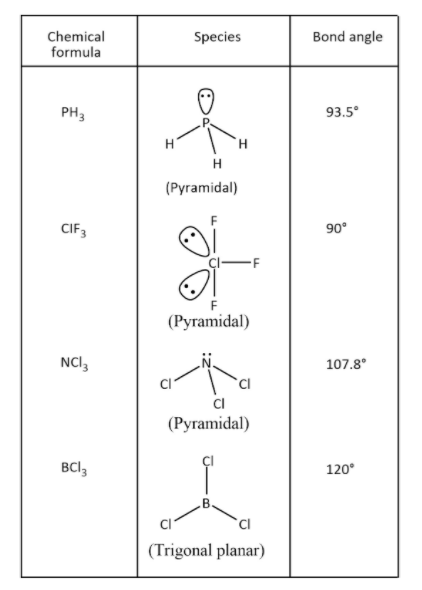
The species having bond angle of
A.
B.
C.
D.
Answer
486.9k+ views
Hint: We know that the bond angle is the angle between the two atoms bonded to the central atom. It is dependent on the non-bonded pairs and the bonded pair.
Complete solution
As per the VSEPR theory, the strength of the repulsion between a lone pair and a bond pair of electrons lies in between the repulsion between two lone pairs and between two bond pairs. The order of repulsion between electron pairs as follows:
Lone Pair- lone pair
Now, let us consider all the species one by one.
a. In
b. In
c. In
d. In
The structure of all species with bond angles are shown below.

Hence, we can say that the correct option is (A).
Note:
The value of angle and shape will be distorted as the non-bonding pair is present. Here, the number of valence electrons is very important to be known in the correct way. Here, the central metal will be the one which is less in number and the other will form the covalent bond by sharing of the electron.
Complete solution
As per the VSEPR theory, the strength of the repulsion between a lone pair and a bond pair of electrons lies in between the repulsion between two lone pairs and between two bond pairs. The order of repulsion between electron pairs as follows:
Lone Pair- lone pair
Now, let us consider all the species one by one.
a. In
b. In
c. In
d. In
The structure of all species with bond angles are shown below.

Hence, we can say that the correct option is (A).
Note:
The value of angle and shape will be distorted as the non-bonding pair is present. Here, the number of valence electrons is very important to be known in the correct way. Here, the central metal will be the one which is less in number and the other will form the covalent bond by sharing of the electron.
Recently Updated Pages
Master Class 11 Economics: Engaging Questions & Answers for Success

Master Class 11 Business Studies: Engaging Questions & Answers for Success

Master Class 11 Accountancy: Engaging Questions & Answers for Success

Master Class 11 English: Engaging Questions & Answers for Success

Master Class 11 Computer Science: Engaging Questions & Answers for Success

Master Class 11 Maths: Engaging Questions & Answers for Success

Trending doubts
State and prove Bernoullis theorem class 11 physics CBSE

1 ton equals to A 100 kg B 1000 kg C 10 kg D 10000 class 11 physics CBSE

State the laws of reflection of light

One Metric ton is equal to kg A 10000 B 1000 C 100 class 11 physics CBSE

Difference Between Prokaryotic Cells and Eukaryotic Cells

1 Quintal is equal to a 110 kg b 10 kg c 100kg d 1000 class 11 physics CBSE




